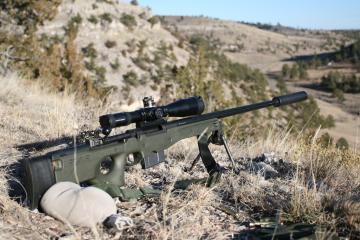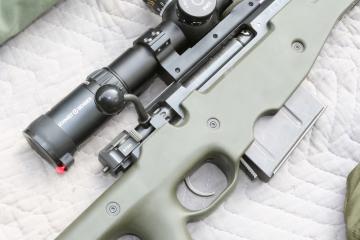
In the early 1980's, the U.S Navy sought a new cartridge for long-range competition. Research Armament Industries (RAI) developed a .338 caliber wildcat using a rimless .416 Rigby case. After a few years of testing the .338/.416, U.S. Armed Forces lost interest and chose to focus on the .50 BMG instead. Lapua picked up the pieces, strengthened the case design, and created the .338 Lapua Magnum cartridge. The .338 Lapua splits the difference between .308 sniper rifles and .50 BMG anti-materiel rifles, with an effective range of 1500 yards against man-sized targets. Rifles chambered in .338 Lapua are the same size and weight as other long-action calibers like .300 Winchester Magnum, or about half the weight of a .50 BMG rifle. This makes a dramatic difference in mobility for shooter and spotter teams.
Accuracy International (AI) was established in 1978 by World Champion rifle shooter Malcom Cooper along with Dave Walls and Dave Caig. They produced one of the first modern sniper rifles, the Precision Marksman (PM), which was adopted by the British as the L96 in 1985. AI modified the rifle to work better in arctic environments and this Arctic Warfare (AW) model was adopted by the Swedish Army in 1990. They had a vision for a multi-purpose long-range sniper caliber and this idea came to fruition in the Arctic Warfare Super Magnum (AWSM) sniper rifle chambered in .338 Lapua, which was adopted as the L115A1 in British service.

The AWSM receiver has a built-in proprietary dovetail for the AI single-piece scope mounts, or the rifle can be ordered with a permanently-mounted Picatinny rail. Its bolt has six lugs, in two in-line sets of three, which provide a short 60-degree bolt throw and low bolt profile. The bolt has an external claw extractor and a standard spring-loaded ejector. Screwed into the receiver is a 27-inch fluted stainless cut-rifled barrel, threaded on the muzzle end for the factory brake or a sound suppressor. The flat-bottomed AI receiver is permanently bonded to an aluminum chassis that extends from the butt-stock to front of the forend. Stock-side "skins" are then clam-shelled around the chassis to create the stock. Because of this design, the rifle is unaffected by environmental changes; bedding is not required. The AWSM is also available with a robust folding stock. Sponsor link - Looking for a SAKO TRG-22 chambered in .260 Remington? Euro Optics has them!
|